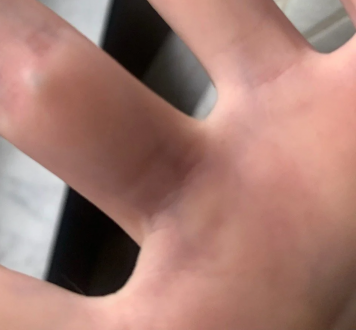Thrombosis of the palmar digital veins was first described by Jadassohn in 1936. It is considered a type of Deep Vein Thrombosis. Deep vein thrombosis is common and well-known, superficial vein thrombosis is uncommon. It is crucial to understand DVT since it can strike anyone and result in significant disease, paralysis, and, in some circumstances, death.
Duplex ultrasonography is the most common way to diagnose DVT. A sonographer examines blood flow in your veins with an ultrasound machine that sends sound waves through your leg.
Deep Venous Thrombosis can be treated by a therapy named percutaneous transcatheter treatment. A catheter, a thin, flexible tube, is used in the treatment to help remove the blood clot.
Palmar Digital Vein Thrombosis is a disease in which a patient develops a bluish-colored nodule that appears on the palmar or lateral side of the fingers. It is most commonly seen around the proximal interphalangeal joint or near the distal interphalangeal joint. The victims of this disease are mostly women of age between 45 to 65 years.
Palmar digital vein thrombosis is diagnosed mostly through clinical symptoms, though noninvasive ultrasonography can be used to confirm the diagnosis. It is important to diagnose the disease at the early stages because it may lead to the development of cancerous nodules that may ultimately lead to the death of the patient.
There are three subtypes of thrombosis of the digital veins. The first resembles thrombotic episodes in veins or varicose veins of the limbs clinically. The second type occurs in an already-existing normal vein or as a result of an acquired venous cavernoma. Mondor’s phlebitis of the finger is the third category, which resembles Mondor’s disease.
Palmar Digital Vein Thrombosis Symptoms
A Palmar Digital Vein Thrombosis occurs most usually in a deep vein. The following are common symptoms of palmar digital vein thrombosis that is vein stiffness and vein tenderness. A vein may swell if it becomes inflamed due to a hand infection, trauma, or autoimmune illness.
The other symptoms might include; abnormality in the color of the fingers, difficulty in moving the fingers, and ripped skin of the fingers.
Palmar Digital Vein Thrombosis Causes
Normally, blood flows quickly through veins and does not solidify (clot). A Palmar Digital Vein Thrombosis can happen for no obvious reason. The following factors, on the other hand, increase the chances of developing the disease:
- Lack of movement or immobility.
- Deep vein injury.
- Pregnancy also leads to the formation of this thrombosis.
- Heart and cancer patients have an increased risk of developing palmar digital vein thrombosis.
- Obesity can cause palmar digital vein thrombosis.
- Dehydration
- Aging
- Hypertension
- Kidney Failure
- Smoking
Palmar Digital Vein Thrombosis Treatment
Palmar digital vein thrombosis is tested through X-ray, MRI, or other imaging tests to check for fractured bones and other internal damage, ultrasound or other tests to evaluate blood flow in arteries and veins, and artery pressure or pulse recordings.
If the patient is not injured, the doctor will almost certainly want to know what caused the blood clot. In this instance, diagnostic testing may involve the blood count, blood coagulation test, and blood chemistry.
Conservative therapy, such as massage and compression, is the mainstay of treatment. If the problem is unpleasant or progressing, surgical removal may be considered.
While some blood clots in the fingers heal on their own without treatment, it is still prudent to consult a physician. This can help avoid irreversible harm to the finger. It can also help to avoid the more dangerous consequences of blood clots that break off and enter the bloodstream from occurring.
If a patient has a blood clot behind the fingernail, the nail may come off. The doctor can cut a tiny hole in the nail to relieve the pressure and prevent this from happening.
Thrombosis of Palmar Digital Veins can be treated at home. The treatment might involve things like rubbing the lesion, administering hot compresses, and wearing compression bandages.
A blood clot in the finger can sometimes be surgically removed. A doctor may prescribe a blood-thinning medicine if a person is prone to blood clots (anticoagulant). These drugs can help prevent new clots from developing.
It is evident from the above-mentioned symptoms and causes of Palmar Digital Vein Thrombosis that it is important to treat the disease as soon as possible. These blood clots might become fatal if ignored for a long period. So, in case of injury inside the veins, the proper medical treatment is advised as mentioned above.
 Health & Care Information
Health & Care Information 


